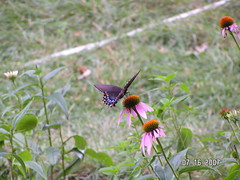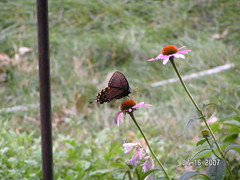JR : Gardening
Books :
- Lawns (Rodale's Organic Gardening Basics)
- Farmer John's Cookbook: The Real Dirt on Vegetables - Seasonal Recipes and Stories from A Community Supported Farm
- A Slice of Organic Life - review
Toledo Talk article titled: Ten Mile Creek Farm - Community Supported Agriculture. This CSA is located near Berkey in western Lucas County.
June 2007
A small sunflower I think came from birdseed, and swamp milkweed, which is an Oak Openings native that the butterflies enjoy, especially the Monarchs. The towering oak trees provide shade and mottled lighting.
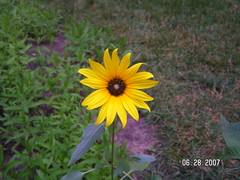

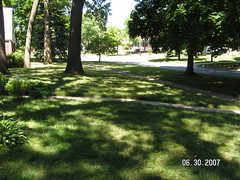
Three noisy, recently-fledged Blue Jays stop by for drink.
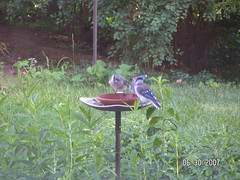
July 2007
My 15-year-old indoor cat, Comet, enjoying a taste of the outdoors. Literally. I forget the name of the plant in the background that grows low to the ground, but Comet enjoyed rolling around in it. He's done that in the past too.
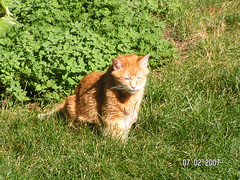
Some of the "Black Valentine" green beans planted at the end of May are ready to be picked. Photos from earlier in the week:
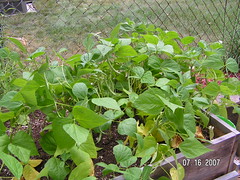
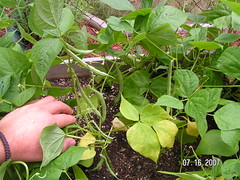
Organically-grown green beans from the back yard, it can be done in the city. The beans taste great. Only problem is, we don't grow enough of them. I need to build more bean boxes. We don't have enough room nor sun to grow them in our yard, so I built 4' × 2' wooden boxes with 12" walls. Our beans grow over our concrete driveway.
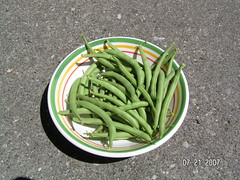

Some tomatoes are starting to ripen.
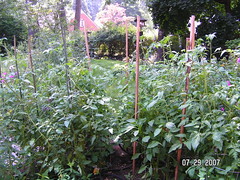
Recent rains have greened things up again.


Lawn maintenance
2007:
- early or mid-May, applied Espoma Turf-tone lawn food (18-0-3).
- mid-July, applied Espoma Dried Blood (12-0-0).
- mowed on July 29. first mowing since the third or fourth week of June.
- mowed in mid-Aug.
- mowed Aug 27.
Corn Gluten Meal
Corn gluten meal is a by-product of processing corn to make corn starch and corn syrup. It is generally sold as a golden yellow meal or as light brown granules. In addition to its use as an herbicide, it is used as food for cows, cats, dogs, fish, and poultry. Corn gluten meal is about 10 percent nitrogen so it's a good natural fertilizer.Corn gluten meal prevents sprouting seeds from developing normal roots. This does not directly kill the seedlings, but makes them susceptible to dehydration if the soil gets dry. Established plants are not affected. The developing roots of a number of common weeds are affected by corn gluten meal: crabgrass, creeping bentgrass, smart weed, dandelions, redroot bigweed, purslane, lambsquarter, foxtail, barnyard grass, and Bermuda grass. Crabgrass is a common target of corn gluten meal products. The most susceptible weeds were black nightshade, lambsquarters, creeping bentgrass, curly dock, purslane, and redroot pigweed. Corn gluten reduced root development and survival of all 22 species tested.
Corn gluten meal has been classified by EPA as a "minimum risk pesticide" that is exempt from registration requirements. This means that corn gluten meal products can be sold without going through EPA's registration process. EPA also has registered one corn gluten meal product as a biological pesticide.
Corn gluten meal is typically applied to lawns with a spreader.2 Most corn gluten meal suppliers suggest that between 12 and 20 pounds of corn gluten meal be applied per 1000 square feet of lawn. Typical recommendations also suggest two applications per year, the first one in the spring and a second one in the fall.
To successfully kill weeds with corn gluten meal, timing is crucial. Remember that corn gluten meal needs to be applied when weed seeds are sprouting. Corn gluten meal suppliers recommend timing spring application when "forsythia begins to bloom," or "two weeks before the first crocus, early daffodils, and blooming tulips" because these flowers bloom at the same time that some common weeds germinate. In the coastal Pacific Northwest, March 15 is suggested.
In the fall, corn gluten meal suppliers suggest that you apply the product "following the hot, dry stress period of mid-summer," usually "some time between mid-August and mid-September." In the coastal Pacific Northwest, August 15 is suggested.
For corn gluten meal to be effective, "a drying period is required" after the product is applied. This kills the weeds that have roots damaged by corn gluten meal. Many suppliers also recommend watering in the corn gluten meal before drying out the soil. This means that following application you "irrigate [the] area and then allow for a short drying period."
Good lawn care prevents most pest and weed problems from occurring, so that treatments are not required. EPA recommends that you create a healthy lawn with these steps.
- Build healthy soil.
- Choose grass varieties that do well in your area.
- Mow high and mow often.
- Water deeply and not too often.
- Remove thatch as necessary.
- Be realistic about your lawn. Perfection is not necessary.
If you use corn gluten meal, NCAP recommends that its use be combined with these healthy lawn care practices.
Possible schedule:
- corn gluten meal - late march or early april
- dried blood - mid to late may
- dried blood - early to mid july
- corn gluten meal - late august or early september
Espoma.com recommended schedule :
- Early Spring : Weed Preventer Plus 9-0-0*
- Late Spring : Espoma Organic 7-2-2 (optional)
- Early Fall : Weed Preventer Plus 9-0-0*
- Late Fall : Espoma Organic 7-2-2
* Substitute the Espoma Organic 7-2-2 when seeding.
2008
espoma corn gluten weed and feed applied April 8.
Note
I imported/copied this page from my workspace area at ToledoTalk.com.
http://toledotalk.com/cgi-bin/tt.pl/article/2033/Jr_gardening
created by jr on Jul 15, 2007 at 10:47:57 pm
updated by jr on May 12, 2008 at 10:21:16 am
From JR's : articles
934 words - 5751 chars
- 5 min read
created on
updated on
- #
source
- versions
- backlinks
Related articles
Control mildew on plant leaves - Sep 02, 2014
Toledo weather mon oct 24 2016 - Oct 24, 2016
Garden notes for late june and early july 2016 - Jul 20, 2016
Growing tomatoes inside from seeds - Apr 15, 2016
Around home nature notes for May 18, 2015 - May 18, 2015
more >>
